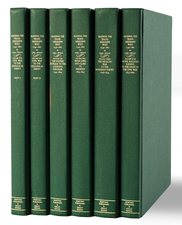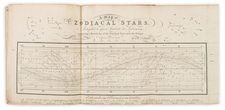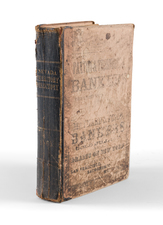"The Most Important Scientific Book of 18th-Century America"
1754 First Collected Edition. Second Overall.
Franklin earned the distinction of being the first American recognized internationally for his groundbreaking work in pure science, particularly in the field of electricity. His major contribution was developing a popular theory of electrical activity, advocating for the notion of a single electric fluid and the conservation of charge principle. He also explored the charge distribution in the Leyden jar, a type of capacitor. He enriched scientific terminology with terms such as 'plus' and 'minus,' 'positive' and 'negative,' 'charge,' and 'battery.' Through experimentation, Franklin demonstrated that lightning is an electrical phenomenon, which led him to invent the lightning rod.
These significant discoveries in electricity are documented in the collected works described here, which include the second edition of Parts I and II (the first editions are exceedingly rare) and the first edition of Part III. Authored as a sequence of letters to his principal British correspondent, Peter Collinson, many of these letters were first published in the Philosophical Transactions of the Royal Society. According to Paul Leicester Ford these famous experiments were actually the work of four men: Benjamin Franklin, Philip Syng, Thomas Hopkinson and Ebenezer Kinnersley, though Franklin received all of the credit since he wrote them down and shared them with Collinson.
The most dramatic result of Franklin's researches was the proof that lightning is really an electrical phenomenon. Others had made such a suggestion before him - even Newton himself - but it was Franklin who provided the experimental proof. In 1752 Franklin flew a kite in a thunderstorm and attached a key to its string. In this experiment he collected electric charges in a Leiden jar and showed that atmospheric and frictional or machine-made electricity are the same. His reputation as a scientist was immediately established by the publication of the results of his researches in a series of letters addressed to Peter Collinson, a London merchant and naturalist - Printing and the Mind of Man.
A very nice example of "America's first great scientific contribution" (Howes).
Franklin relates something of the history of the publication of this work in his Autobiography:
I wrote.... [Collinson] several letters containing accounts of our experiments. He got them read in the Royal Society, where they were not at first thought worth so much notice as to be printed in their Transactions... The papers, however, being shown to Dr. Fothergill, he thought them of too much value to be stifled, and advis'd the printing of them. Mr. Collinson then gave them to Cave for publication in his Gentleman's Magazine; but he chose to print them separately in a pamphlet, and Dr. Fothergill wrote the preface. Cave, it seems, judged rightly for his profit, for by additions that arrived afterward, they swell'd to a quarto volume, which has had five editions.
London: D. Henry and R. Cave, 1754.
First Collected Edition: A Bibliographical Curiosity
The present book represents what can be styled the first collected edition of Franklin's Experiments on Electricity - it is the first to have the constituent three parts under a uniform title (New Experiments and Observations on Electricity), and with the same date (1754) - as such, it is very rare in the market and bibliographically quite interesting. Specifically, this volume comprises the Second Edition of Parts I and II, with the first edition of Part III. Each part has its own title page, with all three bearing the same imprint dated 1754: "Printed and sold by D. Henry, and R. Cave, at St. John's-Gate. 1754." The three parts have continuous signature marks. Interestingly, each title page bears a separate original publisher's price (Part I is 2s 6 d; Part II 6 d; Part III 1 s), which suggests that Henry & Cave made the individual parts available to customers based on their requirements. This would result in examples containing a combination of various editions of the three parts having been bound up by their owners. The errata leaf at the end of Part II (captioned "Additional Errata in Part I") lists several corrections for Part I, with only some (not all) having been corrected (in print) in the present Second Edition of Part I.
It would stand to reason that as interest in Franklin's experiments hit an initial peak in 1754, the book-buying audience had expanded to warrant this second edition of Part I, while the remaining supplements were still in the process of appearing in print. The present volume likely dates from that time, before the additional parts were published.
The first edition of the first part was issued by E. Cave in 1751. The first edition of Part II was issued in 1753, under the title Supplemental Experiments and Observations on Electircity [sic]. Part III was first issued in 1754. By 1769 a fourth edition, with additional notes and plates appeared.
Rarity
We find no copy of the 1754 first collected edition having sold at auction since 1970.
Pagination. [2], 86; [2], 89-109, [1, "Additional Errata in Part I"]; [4],[111]-154 pages plus folding engraved plate. Complete.












![(Chicago World's Fair & St. Paul, Minn.) [Contemporary album of 71 Photographs of St. Paul and Chicago World's Fair, Columbian Exposition]](https://storage.googleapis.com/raremaps/img/small/87334.jpg)
![(Southern California) Utazás Kalifornia Déli Részeiben [Travel in Southern California] [with map:] Kalifornia déli részei Legújabb kútfök után szerkesztette es rajzolta. [Southern parts of California Edited and drawn after the latest sources.]](https://storage.googleapis.com/raremaps/img/small/92022.jpg)

![Opusculum Geographicum Rarum [with map:] Universalis Orbis Descriptio, Cogimur e Tabula Pictos Ediscere Mundos.](https://storage.googleapis.com/raremaps/img/small/95970.jpg)
